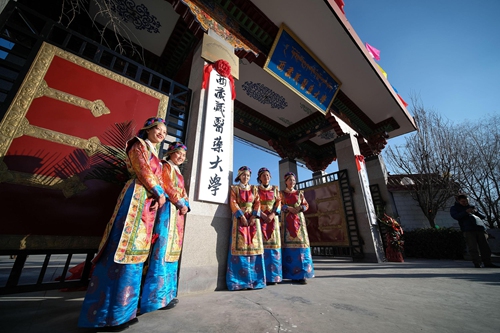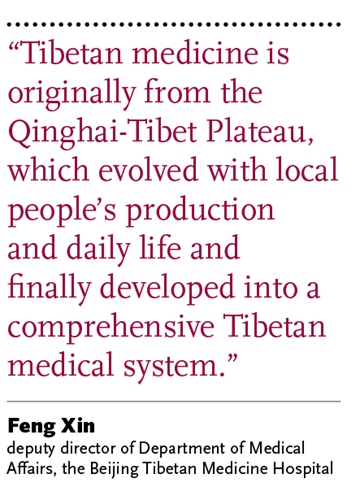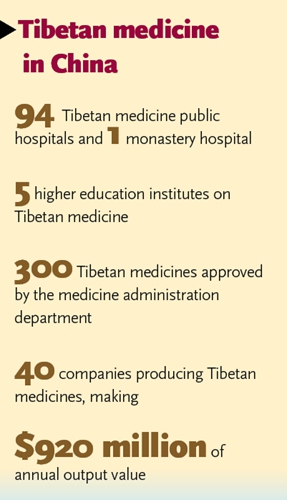China makes great efforts promoting Tibetan medicine as India continues hyping its claim
By Shan Jie Source:Global Times Published: 2019/11/27 19:53:40
○ China has witnessed great achievements in protecting and developing Tibetan medicine
○ Tibetan medicine originates from the Qinghai-Tibet Plateau
○ India has been hyping its claim to Tibetan medicine, say experts

As China's first university for Tibetan medicine, the school in Lhasa, Southwest China's Tibet Autonomous Region, has maintained 7,000 talents on Tibet medicine. The university has six key national-level labs and provides seven undergraduate courses, according to the website of the university. The university has sent experts to promote Tibetan medicine in 24 countries around the world.
The development and achievements of Tibetan Traditional Medical University go along with the process of developing Tibetan medicine in China.
Tibetan medicine, or Sowa Rigpa in Tibetan, is over 2,000 years old. Tibetan medicine was developed on the Qinghai-Tibet Plateau. In the past decades, it has prospered in China with public policy support.
In November 2018, UNESCO inscribed China's Lum medicinal bathing of Tibetan medicine, or Sowa Rigpa, a part of Tibetan medicine, on the representative list of intangible cultural heritage of humanity.
In the past years, India has been seeking to recognize Tibetan medicine as its own intangible cultural heritage by trying to apply to UNESCO. It has approved establishment of an institute in a disputed border region.
Born on the plateau
"Tibetan medicine is originally from the Qinghai-Tibet Plateau, which evolved with local people's production and daily life and finally developed into a comprehensive Tibetan medical system," said Feng Xin, deputy director of the Department of Medical Affairs at the Beijing Hospital of Tibetan Medicine.
Luobu Zhaxi, vice director of the Tibetan Medical Center at the China Tibetology Research Center in Beijing, told the Global Times on Monday that the development of Tibetan medicine has seen great achievements in China.

According to Article 21 of China's Constitution, the country "promotes modern medicine and traditional Chinese medicine."
Scientific approval
According to Luobu Zhaxi, previously Tibetan medicine lacked support from experimental data, which has been a barrier for it to work with modern medicine.
"People might think as Tibetan medicine uses minerals, so it is toxic," he said, "but minerals are just the ingredients. There is also the process to remove the toxin inside."
He noted that China is working on collecting experimental data and safely evaluating Tibetan medicine.
China is also working to standardize Tibetan medicine.
Scientists at the Northwest Institute of Plateau Biology under Chinese Academy of Sciences have produced standard samples for six ingredients used in Tibetan medicines, the Science and Technology Daily reported in July. A lab specialized on the standardization authentication in the institute has been approved.
More than 300 Tibetan medicines have been approved by the medicine administration department in China, among which some are included in the health care system, Luobu Zhaxi said.
A total of 40 companies together make an annual output value of 6.5 billion yuan (920 million) on producing Tibetan medicines, he said.
Companies that produce Tibetan medicines could enjoy tax benefits according to China's policies to develop Tibetan medicine.

The Ganlu Company in Tibet Autonomous Region uses the 6 million yuan saved from taxes to increase employment, which also helps reduce poverty in Tibet.
India's attempt
In an article titled "India, China spar over legacy of Tibetan medicinal system" by Press Trust of India (PTI) on Sunday, an anonymous Indian official said that "India has approached UNESCO, seeking the enlisting of the Sowa Rigpa as its intangible cultural heritage."
The official noted that India was "strongly pushing" the UNESCO application. The Ministry of Ayurveda, Yoga & Naturopathy, Unani, Siddha, Sowa Rigpa and Homoeopathy, has closely worked with the Ministry of External Affairs on the issue, according to PTI.
PTI reported that India's Union Cabinet on November 20 approved setting up a national institute for Sowa-Rigpa in Leh, Ladakh.
"India set the Tibetan medicine institute in Ladakh on purpose, so that India could assimilate the region in order to merge Ladakh into India," Hu Zhiyong, a research fellow at the institute of international relations of the Shanghai Academy of Social Sciences, told the Global Times on Tuesday.
"India has been hyping its work on Tibetan medicine," Hu said, adding that India wants to transfer its people's attention away from economic decline by worsening China-India relations.
On October 31, the Indian government announced the establishment of the Union Territory of Ladakh, which involves Chinese territory.
"This is illegal, null and void," Chinese Foreign Ministry Spokesperson Geng Shuang said at that day's press conference. "It will neither change the fact that the relevant region is under China's actual control nor produce any effect."

Newspaper headline: Cure from the plateau
○ Tibetan medicine originates from the Qinghai-Tibet Plateau
○ India has been hyping its claim to Tibetan medicine, say experts

The Tibetan Traditional Medical University in Lhasa holds a renaming ceremony in 2018. Photo: VCG
Tibetan Traditional Medical University celebrated its 30th anniversary of founding on November 16.As China's first university for Tibetan medicine, the school in Lhasa, Southwest China's Tibet Autonomous Region, has maintained 7,000 talents on Tibet medicine. The university has six key national-level labs and provides seven undergraduate courses, according to the website of the university. The university has sent experts to promote Tibetan medicine in 24 countries around the world.
The development and achievements of Tibetan Traditional Medical University go along with the process of developing Tibetan medicine in China.
Tibetan medicine, or Sowa Rigpa in Tibetan, is over 2,000 years old. Tibetan medicine was developed on the Qinghai-Tibet Plateau. In the past decades, it has prospered in China with public policy support.
In November 2018, UNESCO inscribed China's Lum medicinal bathing of Tibetan medicine, or Sowa Rigpa, a part of Tibetan medicine, on the representative list of intangible cultural heritage of humanity.
In the past years, India has been seeking to recognize Tibetan medicine as its own intangible cultural heritage by trying to apply to UNESCO. It has approved establishment of an institute in a disputed border region.
Born on the plateau
"Tibetan medicine is originally from the Qinghai-Tibet Plateau, which evolved with local people's production and daily life and finally developed into a comprehensive Tibetan medical system," said Feng Xin, deputy director of the Department of Medical Affairs at the Beijing Hospital of Tibetan Medicine.
Luobu Zhaxi, vice director of the Tibetan Medical Center at the China Tibetology Research Center in Beijing, told the Global Times on Monday that the development of Tibetan medicine has seen great achievements in China.

Photo: Global Times
China has 94 Tibetan medicine public hospitals, a monastery hospital and five higher education institutes for maintaining talent.According to Article 21 of China's Constitution, the country "promotes modern medicine and traditional Chinese medicine."
Scientific approval
According to Luobu Zhaxi, previously Tibetan medicine lacked support from experimental data, which has been a barrier for it to work with modern medicine.
"People might think as Tibetan medicine uses minerals, so it is toxic," he said, "but minerals are just the ingredients. There is also the process to remove the toxin inside."
He noted that China is working on collecting experimental data and safely evaluating Tibetan medicine.
China is also working to standardize Tibetan medicine.
Scientists at the Northwest Institute of Plateau Biology under Chinese Academy of Sciences have produced standard samples for six ingredients used in Tibetan medicines, the Science and Technology Daily reported in July. A lab specialized on the standardization authentication in the institute has been approved.
More than 300 Tibetan medicines have been approved by the medicine administration department in China, among which some are included in the health care system, Luobu Zhaxi said.
A total of 40 companies together make an annual output value of 6.5 billion yuan (920 million) on producing Tibetan medicines, he said.
Companies that produce Tibetan medicines could enjoy tax benefits according to China's policies to develop Tibetan medicine.

Photo: Global Times
The Jinhe Tibetan medicine company in Northwest China's Qinghai Province has saved 15 million yuan thanks to the policy. The company used the money to upgrade its technology and buy two new automatic production lines.The Ganlu Company in Tibet Autonomous Region uses the 6 million yuan saved from taxes to increase employment, which also helps reduce poverty in Tibet.
India's attempt
In an article titled "India, China spar over legacy of Tibetan medicinal system" by Press Trust of India (PTI) on Sunday, an anonymous Indian official said that "India has approached UNESCO, seeking the enlisting of the Sowa Rigpa as its intangible cultural heritage."
The official noted that India was "strongly pushing" the UNESCO application. The Ministry of Ayurveda, Yoga & Naturopathy, Unani, Siddha, Sowa Rigpa and Homoeopathy, has closely worked with the Ministry of External Affairs on the issue, according to PTI.
PTI reported that India's Union Cabinet on November 20 approved setting up a national institute for Sowa-Rigpa in Leh, Ladakh.
"India set the Tibetan medicine institute in Ladakh on purpose, so that India could assimilate the region in order to merge Ladakh into India," Hu Zhiyong, a research fellow at the institute of international relations of the Shanghai Academy of Social Sciences, told the Global Times on Tuesday.
"India has been hyping its work on Tibetan medicine," Hu said, adding that India wants to transfer its people's attention away from economic decline by worsening China-India relations.
On October 31, the Indian government announced the establishment of the Union Territory of Ladakh, which involves Chinese territory.
"This is illegal, null and void," Chinese Foreign Ministry Spokesperson Geng Shuang said at that day's press conference. "It will neither change the fact that the relevant region is under China's actual control nor produce any effect."

Photo: Global Times
Newspaper headline: Cure from the plateau